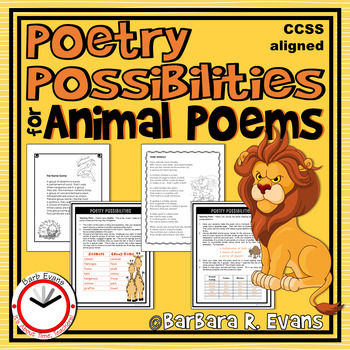POETRY UNIT Animal Poetry Activities Poetry Elements Writing Science
- PDF
Also included in
- POETRY POSSIBILITIES MEGA BUNDLE Save 20%! 12 POETRY POSSIBILITIES units are combined into one economical bundle. The poems are copy ready for your students' poetry anthologies. A teaching point related to poetry is provided for every poem, as are skill lessons and activities. The reading rangePrice $45.26Original Price $64.66Save $19.40
Description
POETRY POSSIBILITIES for ANIMAL POEMS is a unit incorporating multiple subjects through poetry. This collection of animal poems provides teaching points, skill lessons, and activities custom designed for each poem. It masterfully combines language arts with science.
The range of reading levels in these poems makes them appropriate to both primary and intermediate classrooms. This should allow the teacher to accommodate students reading above or below grade level. The skill lessons and activities span this same range. The poems are copy ready, making them easy to add to your students’ poetry anthologies.
Teaching points include:
- Stanzas
- Quatrains
- Tercets
- Alphabet poems
- List poems
- Couplets
- Rhythm
- Rhyme scheme
- Repetition
- Meter & foot
- Onomatopoeia
Skill lessons include:
- Parts of speech
- Punctuation
- Contractions
- Vocabulary
- Synonyms
- Syllables
- Fluency
- Reading for meaning
- Self-checking
- Choral reading
- Counting down
- Ordinal numbers
- Venn diagrams
Activities include:
- Text innovations
- Cloze reading
- Craftivities
Animal concepts covered:
- Hibernation
- Habitat
- Special group names
- Special names for animal family members
- Food chains
CONTENTS
- 12 poems, print ready for student anthologies
- 12 pages of teaching possibilities
- math center
- 7 ordinal numbers task cards
- recording sheet
- answer key
- printables
- zoo map activity + answer key
- animal ordinal numbers worksheet
- Venn diagram printable
- directions for a penguin craftivity
HOW TO USE THIS PRODUCT
- Print the poems you will use, making a copy for each child. Have your students add them to their anthologies.
- Choose the teaching possibilities you wish to employ. Follow the directions provided.
- Most of the lessons supplied can be used with small groups for differentiated instruction.
- Use the skill lessons with individuals for RTI.
- These activities may also be employed with your whole class.
You may be interested in these Poetry Possibilities units, as well:
- Black History Month Poetry Possibilities
- Poetry Possibilities for Water Poems
- 100th Day of School Poetry Possibilities
Barb Evans
CUSTOMER TIPS
► Be the first to know about my new discounts, freebies and product launches. Click here to follow my store. You will now receive customized email updates about my products.
► Get TPT credit to use on future purchases. Please go to your My Purchases page (you may need to login). Beside each purchase you'll see a Provide Feedback button. Simply click it and you will be taken to a page where you can give a quick rating and leave a short comment for the product. Your feedback is important to me. Thank you in advance.
CONNECT WITH ME






